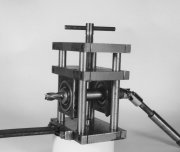 built for a South Bend Lathe. George King designed and built the device to fit on his lathe in place of the compound. The spindle is driven through a U joint and driveshaft from a small motor mounted on the lathebed.
built for a South Bend Lathe. George King designed and built the device to fit on his lathe in place of the compound. The spindle is driven through a U joint and driveshaft from a small motor mounted on the lathebed.General News and Events
The last meeting was held on December 21st at the library. This one probably one of the largest turnouts we have had. Twenty people showed up to share ideas and stories of metalworking. Bill Stone brought in a couple of boring bars he had built for special purposes. One of the devices was for small high precision boring. The other was a large boring bar (about 2" in diameter), machined to fit an Aloris type BXA tool holder. The boring bar used a 1/2" carbide insert tool bit. A few projects were brought in to be included in this month's newsletter. Don Foster brought in a clock that he had built. You will see it later in the newsletter. There was some more discussion on a club project.
What's up, for the New Year
Eight months have gone by since we started putting the Home Metal Shop Club together. We now have 25 members and are still growing. At this point we should review our priorities, and start to plan for the future.
First let's look back at some of our original goals. They were: To set up a forum where members could share experiences and knowledge. To provide a place where members could show off their work for both praise and criticism. To promote the hobby and trade of metalworking.
We have done pretty well. I know I have learned quite a bit about subjects, such as foundry work, that I probably would not have learned elsewhere. We have reviewed many examples of members work. And, by distributing newsletters and membership applications, we have been able to reach several individuals who are interested in metal working.
I have two suggestions that will help make the club stronger and allow more participation by the membership. The first idea is designed to make individual contributions of skill and knowledge easier and more meaningful. The second involves our relationship with the community.
There has been some discussion about building a club project and putting it on display at a local library or other public place. This is not a bad idea, but it may be a little hard for 25 people to build one simple project. When I was an engineering manager, I found people work best in small groups. What I suggest is the following: The club should create several loosely knit Special Interest Groups, or SIG's. The SIG's could center around such topics as steam power, scale modeling, foundry, history, tool design, robotics, etc. The groups would come and go as interests change, but the club would remain as the focus. A SIG would be made up of a few people wanting to pursue an interest or project. The SIG's could report on their work with informal presentations at the meetings. If we have an opportunity to provide a public display, the SIG's could provide the material for the display. It is important that as we grow, we allow for the large diversity of interests and talents in our club, and make sure that the Home Metal Shop Club remains a bonding force to bring all home shop machinists together.
Most of the members of the club have been involved in metalworking either as a trade or hobby for quite some time. Currently our schools, both at the elementary and high school levels, are moving away from vocational education, at least in the metal working trades. If this continues, our hobby and trade will eventually become lost. It should be part of our goal to introduce young people to our hobby, and give them a chance to get involved. One way to do this is to put together small demonstrations that can be used in the classroom. Safety, of course, is important, but it should be no problem to demonstrate a small lathe and show some of the work that can be done. A small sterling engine would be a good example. This is not an unusual project for us to take on. Currently photographic and martial arts clubs do classroom presentations on a regular basis. Certainly we can arouse a little intellectual curiosity when a home made engine or other device is demonstrated. This may help to show kids that building something and seeing it work is at least as exciting as playing a video game.
VIRTUAL VIDEO LIBRARY
A "virtual" video library is under development that will let members borrow VHS tapes on various subjects of metalworking. Here's how we propose it work:
Members are encouraged to share their own videos with others in the club. Let me know if you will loan one or more of your tapes; I will assemble the list of titles and owners. The list will then be published in the newsletter, and if you want to borrow a tape, you contact the owner and make arrangements.
CONDITIONS: As the club will bear no responsibility for loss or damage to shared tapes, it is highly recommended that the borrow time be limited to two weeks; that the owner is urged to ask for a deposit at least equal to replacement costs, and that all incidental costs be paid by the borrower, such as cost of mailers or postage or whatever.
For starters, here are few videos from my collection................
Henrob Gas Cutting/Welding ($40) G. Marsden
Bailey Basic Metal Lathe Operation ($25) G. M.
Millermatic Setup/Operation ($10) G.M.
Rogers Forge & Anvil 2vol ($40) G. M.
Let me know what you'll make available and we'll add them. And also, let me know if you have suggestions for improvement to this process.
What Have You Been Up To?
Below are a few of the many projects the members have been working on over the past year.
Bill Stone, Lawney Morales, Feroze Homji, J.D. Wise and George Carlson have all built various pieces of tooling and brought them to meetings for display. John Waits built a gate latch that could hold back Gingus Khan. George Edwards is restoring an Atlas Shaper, and a small Pump-jack.
At the right is a photo of a novel milling attachment built for a South Bend Lathe. George King designed and built the device to fit on his lathe in place of the compound. The spindle is driven through a U joint and driveshaft from a small motor mounted on the lathebed.
built for a South Bend Lathe. George King designed and built the device to fit on his lathe in place of the compound. The spindle is driven through a U joint and driveshaft from a small motor mounted on the lathebed.
Don Foster always has something interesting going on. At the lower left is a photo of a clock he built from plans in The Home Shop Machinist. Power for the clock is provided by a weight hung from a cable wrapped around a drum. Very nice work. Another project Don brought in is shown in the lower right photo. It is a two cylinder wobble type steam engine. One cylinder is plain view, the other is on the opposite side of the engine.

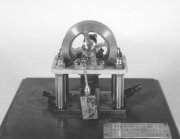
On April 26th and 27th the North American Model Engineering Society will have its annual exposition in Wyandotte, Michigan. Page 8 of the January/February issue of The Home Shop Machinist has an ad detailing information about the event. The pictures below were taken by George Edwards when he went last year. Also, the Henry Ford Museum is just a short drive away.
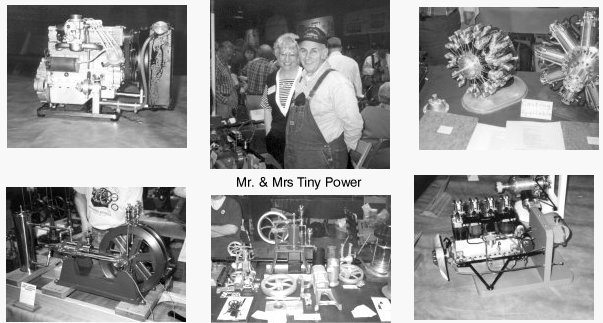
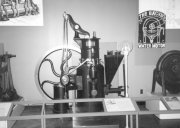
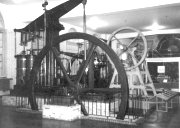
I don't have a project for this month since we didn't use our normal format. So, give this puzzle a try and let me know if you like it. I will publish the solution in the next newsletter.
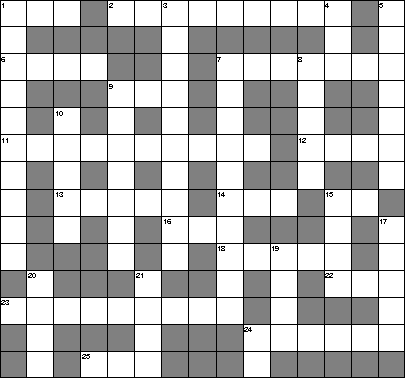
Across Down
1. Short for micrometer. 1. Metric unit of measure.
2. A person who uses machine tools. 3. Device to produce high pressure air.
6. ____ the table or it will move. 4. In a 6-32 screw, the 32 is ___. (abvr.)
7. Cutting tool. 5. Instrument for measuring length.
9. Tool for cutting threads. 7. Tool used for locating on milling machine.
11. Precision measuring instrument. 8. Type of taper.
12. The "#12" in "#12 drill bit" 9. Used to cut metal on lathe.
refers to. 10. Flat instrument used to measure length.
13. Cams have these. 15. Machine for cutting metal.
14. International Standards 17. Jarno is a type of this.
Organization, abvr. 19. Imperial unit of measure.
15. Person who designs mechanical 20. Early man invented this.
devices, abvr. 21. Machine tools use a lot of ____ iron.
16. Every home machinist wants to ___ 24. Système International d'Unitès, abvr.
a lathe.
18. Make a hole.
22. Procedure for making fine fits.
23. Machinist who works to very fine
tolerances.
24. Machine capable of producing flat
surfaces.
25. Used with a bolt.
